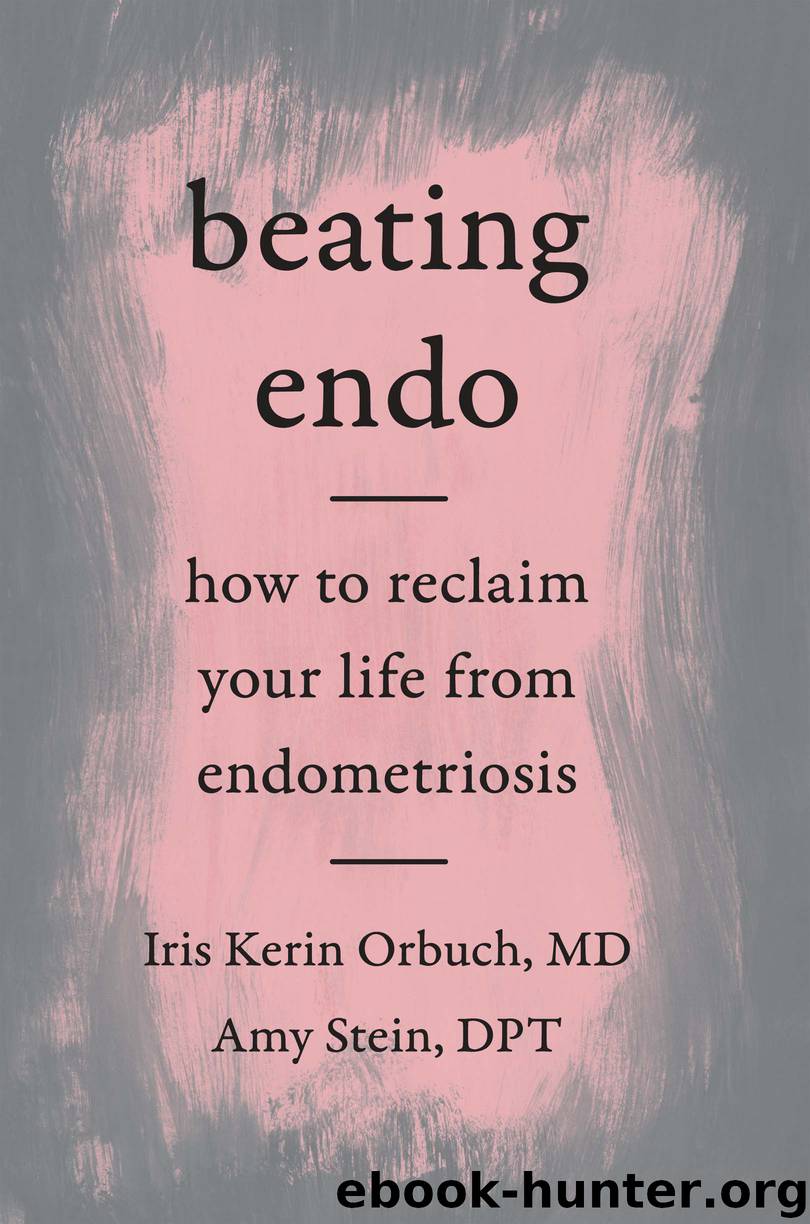Beating Endo by Iris Kerin Orbuch MD

Author:Iris Kerin Orbuch, MD
Language: eng
Format: epub
Publisher: HarperCollins
Published: 2019-05-27T16:00:00+00:00
“MY NERVES ARE BURNING”
That’s what patients tell us all the time. They describe sensations of burning, stabbing, tingling, numbness they feel “in the nerves” that crisscross the pelvic area, even travel down the legs, and for some, cause a shooting pain in the vagina or rectum. In the deepest and most intimate core of their bodies, these women feel like they are on fire.
Dr. Allyson Shrikhande is a physical medicine and rehabilitation specialist and an expert practitioner of a cutting-edge holistic treatment approach to pelvic pain and pelvic floor muscle dysfunction.* She is therefore well acquainted with the “fiery” pain these women describe. First, she says, because endo is “a pro-inflammatory state,” the pelvic nerves of endo-afflicted women are, in Shrikhande’s words, “swimming in an inflammatory soup.” At the same time, the endo sufferer’s abdominal and pelvic floor muscles tend to be in a chronic state of guarding against pain—the clenching action that Shrikhande says renders the muscles short, spastic, and weaker until, as she describes it, the muscles “essentially clamp down.” As Amy adds, those clamped-down muscles “function poorly,” compromising movement and stability.
Over time, that griplike tension in the muscles literally restricts blood flow in the immediate area and changes the pH balance there, which in turn “stimulates the inflammatory cascade” even further, adding to and “enriching” the inflammatory soup. The peripheral nociceptors in the pelvis, firing off like crazy as they sense all the damaging stimuli pouring out of this inflammatory cascade, go on overdrive; their input builds up and pushes the sensory messages up the spinal cord to the CNS and right up to the brain, which tells you that your pelvic area feels like it is on fire. A woman with endo, says Shrikhande, is in effect the target of “nociceptors firing aberrantly” and upregulating her CNS with every shot.
There is an additional factor at work as well: tissue trauma from endo lesions literally infiltrating the nociceptors of the PNS. You read back in chapter 1 about how endo cells grow denser with monthly hormonal fluctuations and how they create their own blood supply, essential for their survival. Those blood vessels are of course supplied with nerves, and as endo implants grow, the lesions also become innervated, and that innervation process follows the same pathway as the lesions—growing deeper, expanding outward, distorting the anatomy. Then somato-visceral and viscero-somatic cross-talk kicks in as well, spreading the pain from muscles and fascia to organ and back again, thereby amplifying the agony yet further. The nociceptors of the PNS fire off even more intently, and the pain just seems to spread.
A very likely prime mover of all this sensory information is the pudendal nerve—remember?—the main nerve of your pelvic floor at the body’s core, the nerve that can play such a key role in painful sex. It is, says pelvic pain PT expert Stephanie Prendergast, a pioneering educator on the subject of pudendal neuralgia,15 “a unique nerve,” the only nerve in the entire body impacting organs and skeletal muscles equally.
Download
This site does not store any files on its server. We only index and link to content provided by other sites. Please contact the content providers to delete copyright contents if any and email us, we'll remove relevant links or contents immediately.
When Breath Becomes Air by Paul Kalanithi(7274)
Why We Sleep: Unlocking the Power of Sleep and Dreams by Matthew Walker(5659)
Paper Towns by Green John(4178)
The Immortal Life of Henrietta Lacks by Rebecca Skloot(3833)
The Sports Rules Book by Human Kinetics(3597)
Dynamic Alignment Through Imagery by Eric Franklin(3501)
ACSM's Complete Guide to Fitness & Health by ACSM(3473)
Kaplan MCAT Organic Chemistry Review: Created for MCAT 2015 (Kaplan Test Prep) by Kaplan(3430)
Introduction to Kinesiology by Shirl J. Hoffman(3307)
Livewired by David Eagleman(3135)
The River of Consciousness by Oliver Sacks(2999)
Alchemy and Alchemists by C. J. S. Thompson(2918)
The Death of the Heart by Elizabeth Bowen(2910)
Descartes' Error by Antonio Damasio(2745)
Bad Pharma by Ben Goldacre(2737)
The Gene: An Intimate History by Siddhartha Mukherjee(2501)
Kaplan MCAT Behavioral Sciences Review: Created for MCAT 2015 (Kaplan Test Prep) by Kaplan(2495)
The Fate of Rome: Climate, Disease, and the End of an Empire (The Princeton History of the Ancient World) by Kyle Harper(2444)
The Emperor of All Maladies: A Biography of Cancer by Siddhartha Mukherjee(2439)
